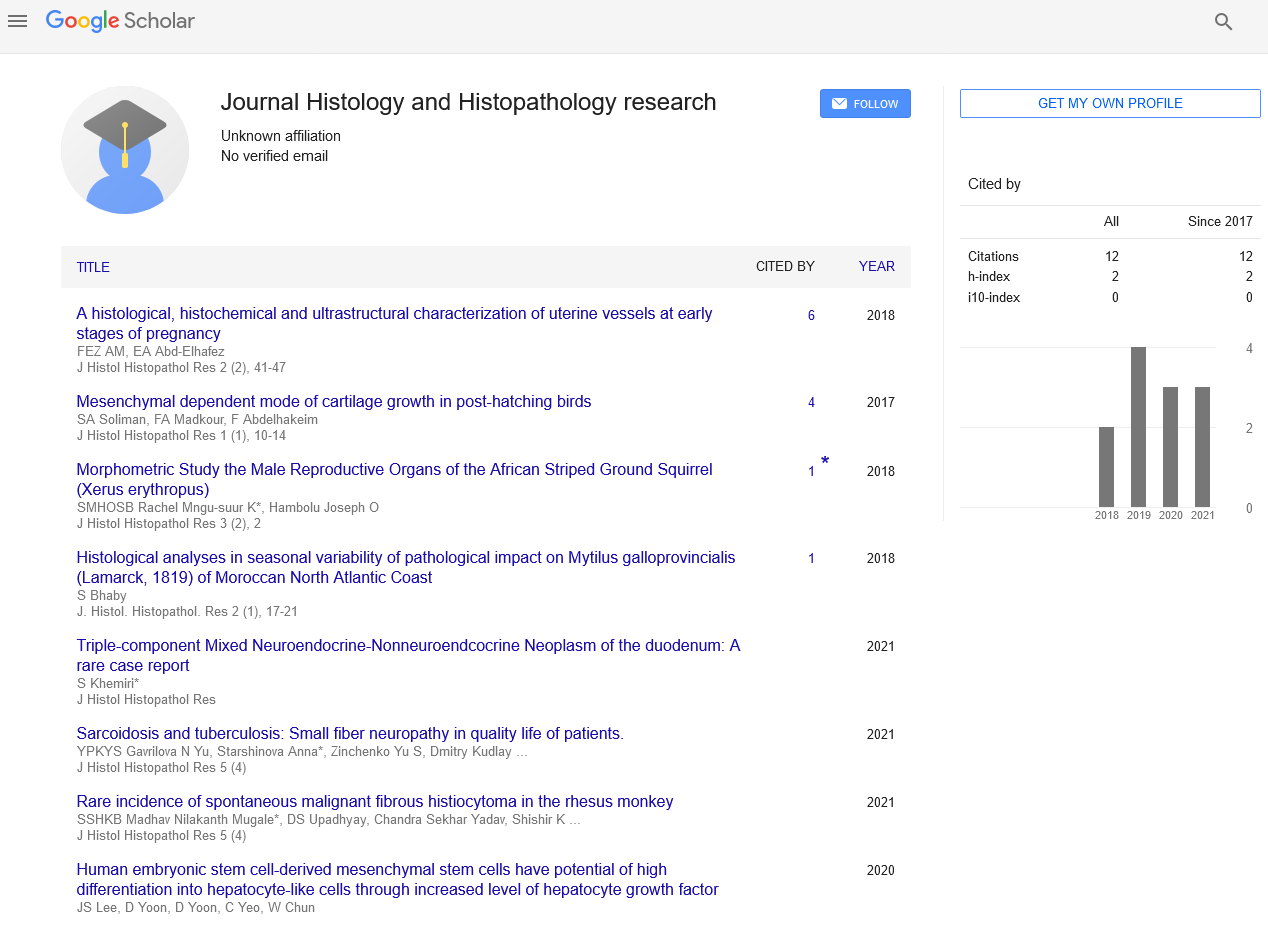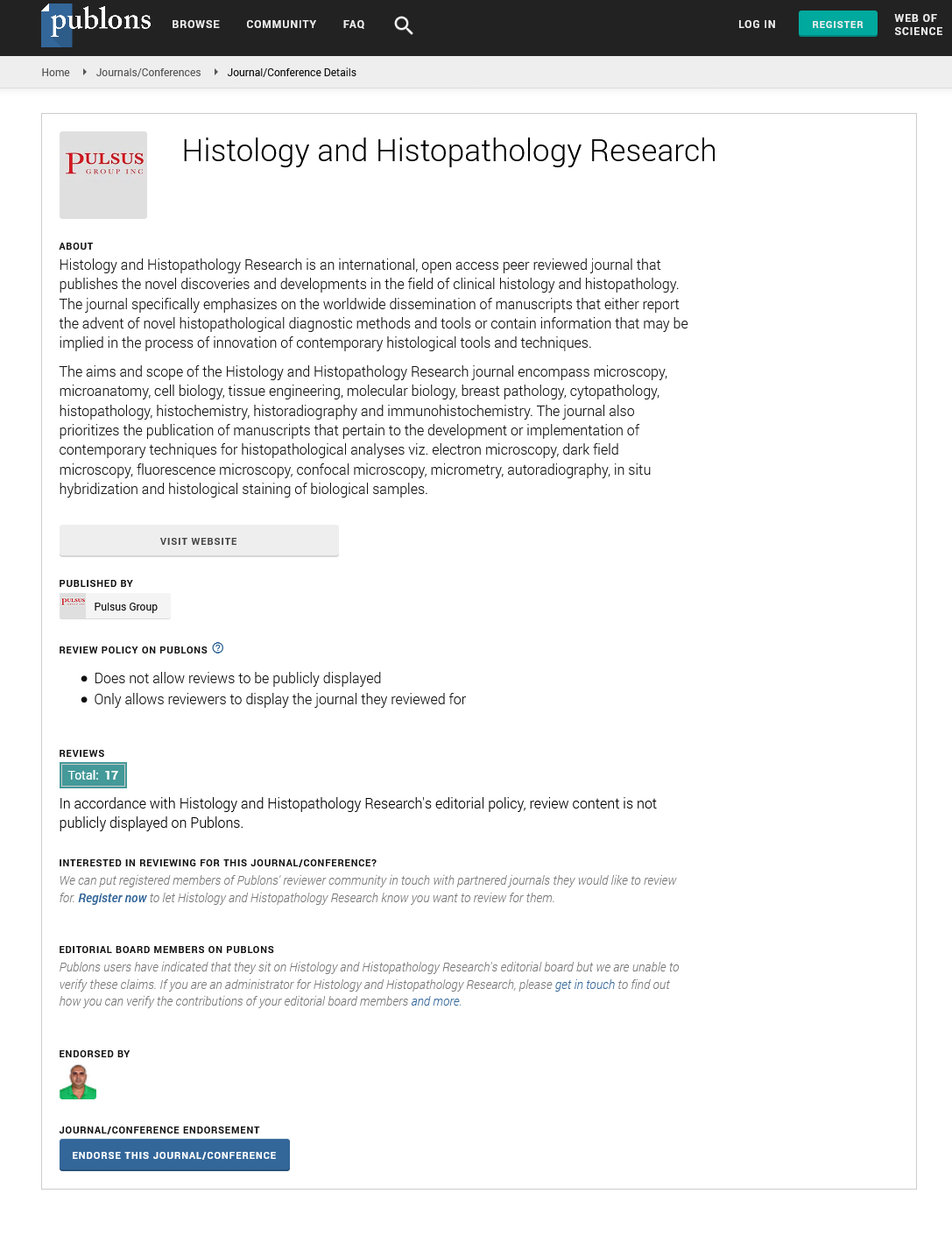Advanced uses of immunohistochemistry in histology and histopathology
Received: 20-Oct-2017 Accepted Date: Oct 24, 2017; Published: 28-Oct-2017
Citation: Abd-Elkareem M. Advanced uses of immunohistochemistry in histology and histopathology. J Histol Histopathol Res 2017;1(1):19-20.
This open-access article is distributed under the terms of the Creative Commons Attribution Non-Commercial License (CC BY-NC) (http://creativecommons.org/licenses/by-nc/4.0/), which permits reuse, distribution and reproduction of the article, provided that the original work is properly cited and the reuse is restricted to noncommercial purposes. For commercial reuse, contact reprints@pulsus.com
Abstract
Immunohistochemistry [IHC] is an important application of monoclonal as well as polyclonal antibodies to determine the tissue distribution of an antigen [protein or lipid] by specific antigen/antibody reaction tagged with a visible label. Immunohistochemistry has an expanding role in diagnostic and research laboratories. This article highlights the various applications of IHC in health and diseases and gives more information in the Future directions of immunohistochemistry.
Keywords
Immunohistochemistry, Histology, Histopathology, Diseases, DiagnosisImmunohistochemistry [IHC] is an integration of histological, immunological and biochemical techniques, which is used for the identification of specific tissue components [antigens] by means of a specific antigen/antibody reaction tagged with a visible label. IHC visualize the distribution and localization of specific cellular markers or components within a cell or tissue [1,2]. IHC used to detect cell or tissue antigens that range from amino acids and proteins to infectious agents and specific cellular populations [3]. Immunohistochemical staining has an important role in the histopathological diagnosis of many tumors [4,5] and diseases [6-10]. In basic research, immunohistochemistry is also widely used to understand the distribution and localization of biomarkers and differentially expressed proteins in different parts of human and animal tissues [1,2].
Application of IHC in Histological Research
In basic research, IHC has become a crucial technique and is widely used in many medical research laboratories. IHC used to understand the distribution and localization of biomarkers and differentially expressed proteins in different parts of human and animal tissues as ovary [11] uterus [12]. IHC is also used in field of mesenchymal stem cells [13], embryonic stem cell [14,15] and Telocytes [16-18] research area. IHC can also be used to determine specific molecular markers in fundamental biological processes such as proliferation, development and apoptosis [19].
Application of IHC in Histopathology
As IHC, can detect the earliest changes in transformed tissues and identifying cellular changes not normally visible with H&E, it can be used to help distinguish hyperplasia from neoplasia [2]. IHC may act as a Prognostic markers in cancer, prediction of response to therapy and to detect infectious agent in tissues by use of specific antibodies against microbial DNA or RNA, e.g. in Cytomegalo virus, Hepatitis B virus, Hepatitis C virus [1].
IHC used in the Histopathology of the Respiratory System and lung [8,20,21] diagnosis, differential diagnosis and classification of soft-tissue tumors [4,5] diagnosis of prostate cancer [22] surgical pathology practice [9] in the Diagnosis of Bioterrorism Agents [7] in mammary pathology and breast cancer [23] Diagnosis of Cutaneous Leishmaniasis [10] and in oral pathology laboratory [24].
In brain trauma, immunohistochemical staining for beta amyloid precursor protein has been used as a method to detect axonal injury within as little as 2–3 h of head injury [6]. This is useful in establishing timing of a traumatic insult in medico-legal settings [1]. In muscle diseases IHC can assist in differentiating vascular dystrophy from non-dystrophicdisorders [1].
Future Directions of Immunohistochemistry
Genogenic immunohistochemistry will help in identification of the underlying molecular changes that can be used both for diagnosis and therapy [25]. Using automated computerized image capture and analysis systems [9,26] will give more accurate results. Development of more specific antibodies from recombinant antibody fragments will give molecules with ultra-high affinity, high stability, and increased potency [9]. The use of tissue microarrays [TMA] as a high-throughput technique enables economical evaluation in terms of sample utilization and reagent costs [9,26].
REFERENCES
- Duraiyan J, Govindarajan R, Kaliyappan K, et al. Applications of immunohistochemistry. J Pharm Bioallied Sci 2012;4:307–9.
- Okoye JO, Nnatuanya IN, Okoye JO, et al. Immunohistochemistry: A revolutionary technique in laboratory medicine. Clin Med Diagn 2015;5:60–9.
- De Matos LL, Trufelli DC, De Matos MGL, et al. Immunohistochemistry as an important tool in biomarkers detection and clinical practice. Biomark Insights 2010;5:9–20.
- Hornick JL. Novel uses of immunohistochemistry in the diagnosis and classification of soft tissue tumors. Mod Pathol 2014;27:47–63.
- Muro-Cacho CA. The role of immunohistochemistry in the differential diagnosis of soft-tissue tumors. Cancer Control 1998;5:53–63.
- Sherriff FE, Bridges LR, Sivaloganathan S. Early detection of axonal injury after human head trauma using immunocytochemistry for beta-amyloid precursor protein. Acta Neuropathol (Berl) 1994;87:55–62.
- Guarner J, Zaki SR. Histopathology and immunohistochemistry in the diagnosis of bioterrorism agents. J Histochem Cytochem 2006;54:3–11.
- Linnoila I, Petrusz P. Immunohistochemical techniques and their applications in the histopathology of the respiratory system. Environ Health Perspect 1984;56:131–48.
- Jambhekar NA, Chaturvedi AC, Madur BP. Immunohistochemistry in surgical pathology practice: A current perspective of a simple, powerful, yet complex, tool. Indian J Pathol Microbiol 2008;51:2.
- Dias PD, Geffen Y, Ben IO, et al. The role of histopathology and immunohistochemistry in the diagnosis of cutaneous leishmaniasis without “Discernible” Leishman-Donovan bodies. Am J Dermatopathol 2017.
- Abd-Elkareem M. Cell-specific immuno-localization of progesterone receptor alpha in the rabbit ovary during pregnancy and after parturition. Anim Reprod Sci 2017;180:100–120.
- Abd Elkareem M. Morphological, histological and immunohistochemical study of the rabbit uterus during pseudopregnancy. J Cytol Histol 2017;8.
- Yang Z, Schmitt JF, Lee EH. Immunohistochemical analysis of human mesenchymal stem cells differentiating into chondrogenic, osteogenic, and adipogenic lineages. Methods Mol Biol Clifton NJ 2011;698:353–66.
- Nethercott HE, Brick DJ, Schwartz PH. Immunocytochemical analysis of human pluripotent stem cells. Methods Mol Biol Clifton NJ 2011;767:201–20.
- Fenderson BA, De Miguel MP, Pyle AD, et al. Staining embryonic stem cells using monoclonal antibodies to stage-specific embryonic antigens. Methods Mol Biol Clifton NJ 2006;325:207–24.
- Qi G, Lin M, Xu M, et al. Telocytes in the human kidney cortex. J Cell Mol Med 2012;16:3116–22.
- Popescu LM, Faussone-Pellegrini MS. Telocytes–a case of serendipity: the winding way from interstitial cells of cajal (ICC), via Interstitial Cajal-Like Cells (ICLC) to telocytes. J Cell Mol Med 2010;14:729–40.
- Cretoiu SM, Cretoiu D, Marin A, et al. Telocytes: Ultrastructural, immunohistochemical and electrophysiological characteristics in human myometrium. Reproduction 2013;145:357–70.
- Whiteside G, Munglani R. Tunel, Hoechst and immunohistochemistry triple-labelling: An improved method for detection of apoptosis in tissue sections—an update. Brain Res Protoc 1998;3:52–3.
- Capelozzi VL. Role of immunohistochemistry in the diagnosis of lung cancer. J Bras Pneumol 2009;35:375–82.
- Leite KRM, Srougi M, Sanudo A, et al. The use of immunohistochemistry for diagnosis of prostate cancer. Int Braz J Urol 2010;36:583–90.
- Betta PG, Magnani C, Bensi T, et al. Immunohistochemistry and molecular diagnostics of pleural malignant mesothelioma. Arch Pathol Lab Med 2012;136:253–61.
- Yeh IT, Mies C. Application of immunohistochemistry to breast lesions. Arch Pathol Lab Med 2008;132:349–58.
- Ajura AJ, Sumairi I, Lau SH. The use of immunohistochemistry in an oral pathology laboratory. Malays J Pathol 2007;29:101–5.
- Gown AM. Genogenic immunohistochemistry: A new era in diagnostic immunohistochemistry. Curr Diagn Pathol 2002;8:193–200.
- Cregger M, Berger AJ, Rimm DL. Immunohistochemistry and quantitative analysis of protein expression. Arch Pathol Lab Med 2006;130:1026–30.






